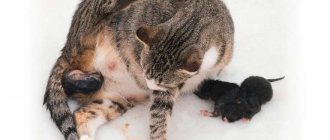The cat usually does not require special care throughout pregnancy. Most cats remain this way when it comes time to give birth to their kittens. The birth occurs without any human intervention, with normal human participation limited to standing aside and giving the mother space.
However, this is not always the case. If your cat is past her due date or you think her health may be in danger, it may be time to induce labor.
When you need help
Is it possible to induce labor in a cat on your own? In some cases, it is not only possible, but also necessary. As a rule, pregnancy in cats lasts 55-60 days. A slight delay in the birth of kittens is normal, but if the animal does not give birth 68-70 days after mating, measures must be taken. The babies grow in the mother's womb, becoming larger and larger, and the larger the kittens, the more complications the birth will be.
© shutterstock
Signs of approaching labor
The duration of a cat's pregnancy is approximately 60 days, give or take five days. If you're not sure how far along your cat is, look for telltale signs that birth is imminent.
- Nesting : A day or two before giving birth, your cat will look for a quiet and safe place to give birth to her kittens. She can choose the place you allocate for her, or hide in the back of a closet or under the bed.
- Changes in behavior : You may notice that your cat begins to pace restlessly, pant, overgroom (especially in the genital area), and sing excessively. She will also stop eating.
- Physical changes during labor : Your cat's rectal temperature may drop to around 37℃ and she may vomit. You may see the belly "drop" in the days before giving birth, and your cat's nipples may become larger, darker, or pinker.
- Signs of active labor : Contractions—the movements of the uterus that move the kitten through the birth canal—may cause your cat to howl in pain. You may also see blood or other fluids discharge.
© shutterstock
Medicines
You can induce labor in a cat at home using certain medical products.:
- Oxytocin . It causes contractions of the uterus and helps speed up the labor process. This synthesized hormone can only be used after consultation with a veterinarian.
- Travmatin . Relieves pain and helps regulate contractions, helps avoid complications and injuries while the animal is giving birth, promotes healing and prevents inflammation.
- Gamavit . Stimulates the uterine muscles, facilitates childbirth in difficult cases.
- Calcium gluconate . Not only stimulates labor, but also helps milk production.
In order not to harm your cat, you should carefully read the instructions for the medications and be sure to consult a veterinarian.
Preparation
Preliminary measures will not be superfluous, although most breeds cope well with pregnancy on their own. So what should you do if your cat gives birth for the first time?
First, we set up a nest. A regular cardboard box is perfect for this. We put a diaper or any other fabric on the bottom for convenience. Experienced owners recommend using several layers of soft paper or baby diapers. Special houses for cats are suitable for nesting. The main thing is that the expectant mother has free access.
Secondly, the cat should build a nest in a warm, ventilated room. We exclude drafts and the presence of other animals. We exclude the toilet and bathroom. The ideal option would be a small room where the cat will not be disturbed. For example, a storage room.
Thirdly, in order for the pet to successfully give birth, it is provided with food and clean drinking water. All this is placed near the nest or place where the cat prefers to sleep. Presumably she will give birth there.
What items will be needed to help the cat, stimulate and speed up the process? The list may change, but if the owner has most of the above, then half the battle is already done:
- Disposable diapers and wet wipes.
- Scissors.
- Disposable syringes and a number of medications to eliminate complications.
- Vaseline oil to stimulate the vaginal muscles.
- Surgical (or silk) thread to tie the umbilical cord.
- Iodine, brilliant green, disinfectants.
How to act
If there is a need to induce contractions in a cat, you need to use Oxytocin. This drug will help strengthen the tone of the muscle tissue of the uterus before labor begins. The medicine is administered intramuscularly or subcutaneously; its effect begins within 2-3 minutes after the injection. It is very important to follow the dosage, otherwise complications may arise, including the death of the kittens.
How much drug should I use? For cats, the following dosage should be used: 0.2-0.3 ml for intramuscular or subcutaneous injection, the injection is given between two contractions. If there is no result within 1/3 hour, the drug is re-administered at the same dose. The maximum number of injections is 3; if there is no effect, you cannot increase the dosage - this will lead to negative consequences.
How to give an injection? To help your pet give birth to offspring, you should inject the drug into the withers. To do this, the animal’s skin is grabbed with one hand and an injection is made into the hollow formed at the back. It is important to puncture the skin and inject the drug between the skin and muscles.
© shutterstock
The intramuscular injection is easy. The optimal place for the injection is the thigh, the paw is held with one hand, and the syringe needle is inserted at an angle with the other hand. After the procedure, the injection site should be gently massaged, this will help the drug dissolve faster. Similar injections are given if the cat carries the pregnancy to term.
It is extremely important to wash your hands thoroughly before injection and use only sterile instruments. The same needle cannot be used twice.
What research must be carried out?
Let us repeat once again - the decision on the advisability of artificial childbirth should be made only by a veterinarian. To accurately determine the need for the procedure, a specialist must conduct a number of diagnostic studies:
- An ultrasound of the entire abdominal cavity is required. This method allows you to find out what condition the animal’s uterus is in, how many formed fetuses are in it, whether there is a malpresentation, or whether a dead kitten is lying across the birth canal.
- It is not recommended, but if it is not possible to do an ultrasound, radiography can be used for the same purposes.
- Blood tests are taken. The veterinarian will be especially interested in the level of hormones, since this sign indirectly indicates the animal’s ability to give birth on its own.
- A visual examination of the external genitalia is also indicated. This can be useful if you suspect infectious diseases that can also slow down the birth process.
Why is all this being done? It’s simple - before inducing labor, the specialist must make sure that the cat’s body can withstand it.
Here is a classic example: a cat that could not give birth (there were no uterine contractions) was injected with a “horse” dose of oxytocin. As a result, there is a need for urgent abdominal surgery. And all because the animal had an incorrect presentation of the kitten, and as a result of powerful contractions of the uterine myometrium, the organ simply tore. The same can happen when the placental membranes fusion with the uterus, if there are benign or malignant tumors in its cavity, etc. Not to mention the cases when the owners incorrectly determined the gestational age, as a result of which the stimulation of labor led to miscarriages.
We repeat once again - “anyhow” using drugs intended to induce labor is strictly prohibited!
Such amateur activities will not lead to anything good. Most likely, the cat itself and all its offspring will die.
Gamavit for obstetrics
This traditional medicine is recommended to be used to help cats during childbirth for several reasons.:
- It helps to avoid uterine rupture due to excessively large offspring;
- It prevents diseases such as endometritis and pyometra.
- Reduces the risk of birth and postpartum complications.
- Allows the animal to quickly return to normal after birth.
The product is used by injection - intravenous, subcutaneous and intramuscular. To speed up the absorption of the medicine into the blood and induce labor, the injection should be given under the shoulder blade. In agreement with the veterinarian, the drug can be given to the cat to drink. For an adult cat, the dosage of the drug for one injection can be from 1 to 1.5 ml.
© shutterstock
Description of the birth process
Inexperienced owners are primarily concerned about the length of the process. The condition of newborns and their possible number are also important.
How long does labor last?
It is impossible to give an exact figure that determines how long a cat’s labor lasts. This indicator is individual. It depends on age, breed and general health. Typically the entire process takes 4-12 hours. If the duration lasts for a day, it is recommended to contact a veterinarian. A negative prognosis is typical when it reaches 48 hours. In this case, urgent surgery is required to save the animal and its offspring.
You can determine how long it will take for a cat to give birth to the next baby by looking at its order. The first two take the longest to come out. The wait may last for several hours. The birth time of the remaining kittens is a few minutes.
How many kittens can be born?
When talking about how cats give birth, it is necessary to note the size of the possible litter. On average, the number of newborns ranges from 2 to 6. Their number depends on the previous pregnancies, breed and age of the woman giving birth. A small number of newborns (1-3) is typical for primiparous, elderly and small pets.
What do newborn kittens look like?
The weight of newborns is 80-120 g, and their body length is 9-12 cm. They are born deprived of sight and hearing, so they really need help from their mother or a person. At first, they sleep constantly and eat a lot. Due to fragile bones, babies cannot stand on their feet. They navigate with the help of a developed sense of smell and touch and use a thin squeak to communicate. At first it is better not to touch them. It is enough to monitor their weight.
How to determine the end of a process
The absence of contractions for 2 hours indicates the end of labor. Full recovery of the body takes 2 weeks. During this time, newborns grow up and become more independent.
What to do if the kitten is born too big
If you have a large fetus, it is recommended to choose one of the following methods for delivery;
- removing the kitten using forceps;
- C-section.
The first method can lead to unwanted complications for the kitten. For example, a leg may break because the muscle and bone tissue is not yet sufficiently developed. Therefore, doctors more often recommend surgery.
Cat with newborn kittens
Freeing the kitten from the amniotic sac
When the fetus is delivered along with the amniotic sac, it is recommended to apply the following rules:
- Do not pull on the umbilical cord, as this may cause a hernia.
- The umbilical cord is cut with sterile scissors with blunt ends 1 cm before the kitten's abdomen.
- The umbilical cord area is cauterized with iodine.
- If the cat does not lick the kitten, rupture the amniotic sac in the area of the kitten’s nose and suck out the fluid from the nose and mouth using an enema.
- They give the newborn to the cat so that she can lick it and apply it to the nipple.
- The placenta is counted, since each of them may not come out immediately after the kitten, but after some time.
Attention! It is extremely important to count the placenta, as if parts of it remain inside the uterus, this will lead to infection and possible death of the animal.
Newborn Sphynx kittens
Be prepared for leaks!
Even after the cessation of lactation or in its last stages, unexpected copious discharge of milk from the breast is possible. This can happen when hugging a partner, when having sex with him, when being sexually aroused, when thinking about a child, when touching the breast. To prevent unexpected milk leaks, wear absorbent pads in your bra. Keep a spare supply of such gaskets with you. Wear dark-colored tops so that milk stains are not as noticeable. Take a spare set of clothes with you, especially for more important occasions.
Express some milk before leaving the house. If you feel milk leaking, cross your arms over your chest to stop the flow.
In all cases, get advice from a breastfeeding specialist on how best to stop lactation in your case.
Causes of problems
It is not difficult for a pregnant pet to give birth at home. However, there are situations when a long period has passed since the start of contractions, but the pet does not give birth for a long time. Often, a cat cannot give birth in the following situations:
- large size kitten;
- malposition;
- traumatic injuries;
- inflammation;
- narrow pelvis;
- incomplete dilatation of the cervix;
- abnormalities in the development of the vaginal vault;
- lack of lubrication;
- advanced age;
- excessive body weight.
Return to contents
Weak labor
However, often a cat cannot give birth due to the influence of the factors described above. One of the most common factors is considered to be weak labor. It is usually divided into 2 types:
Weak uterine contractions are possible when the pet’s body does not produce enough oxytocin.
- Primary light tone of the uterus. It is observed due to a lack of the hormone oxytocin in the body, which is responsible for the frequency of contractions. Sometimes this condition can be caused by a lack of calcium.
- Secondary. Cessation of uterine contractions due to severe exhaustion of the female during labor.
Return to contents











